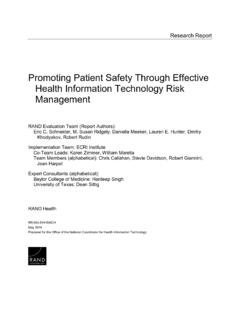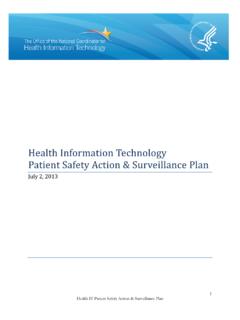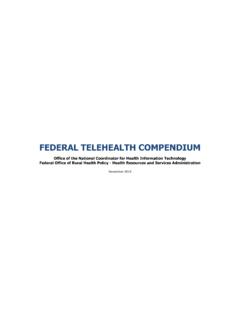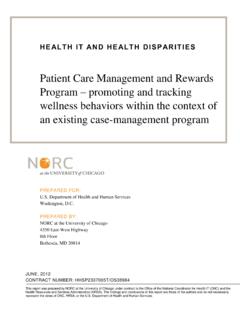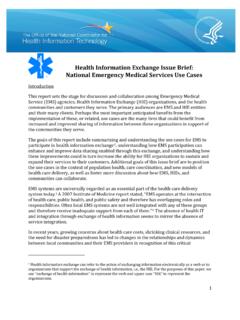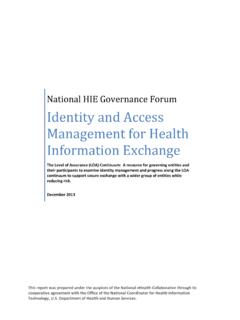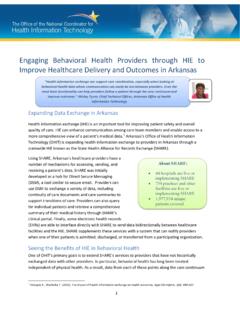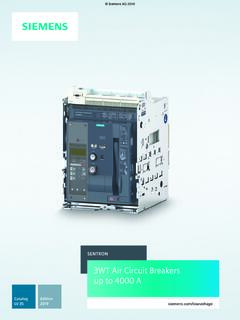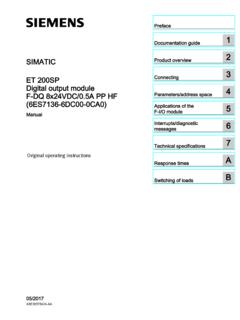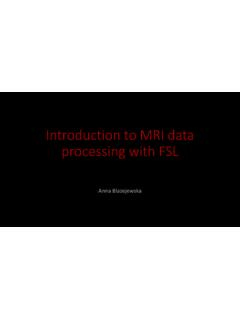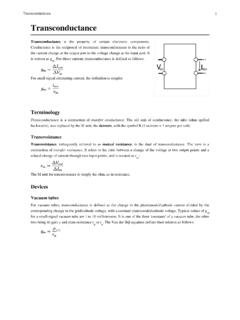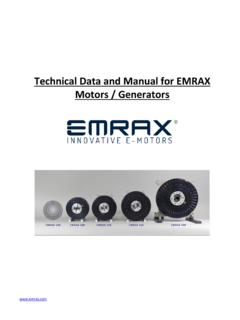Transcription of Hospitals’ Use of Electronic Health Records Data, 2015-2017
1 ONC Data Brief No. 46 April 2019 Hospitals Use of Electronic Health Records Data, 2015-2017 Sonal Parasrampuria, MPH and Jawanna Henry, MPH The Health Information Technology for Economic and Clinical Health (HITECH) Act of 2009 helped to advance the adoption and meaningful use of Electronic Health Records (EHRs). Today, more than 95 percent of hospitals possess an EHR (1 ). With widespread adoption of EHRs, policy is now shifting towards the use of EHR data. EHR data can improve patient care by giving providers access to evidence based tools that assist with decision making and facilitating clinical practice by automating and streamlining the provider workflow (2). This brief uses data from the American Hospital Association Information Technology Survey to describe trends in the use of EHR data among non-federal acute care hospitals from 2015 to 2017 .
2 We defined use of EHR data as a set of ten measures that describe hospital processes for leveraging data within their EHR to inform clinical practice (see appendix for survey details). The data brief also presents variation in the use of this data by hospital characteristics and over time. HIGHLIGHTS As of 2017 , 94 percent of hospitals used their EHR data to perform hospital processes that inform clinical practice. EHR data is most commonly used by hospitals to support quality improvement (82 percent), monitor patient safety (81 percent), and measure organization performance (77 percent). Hospital characteristics significantly impact the use of EHR data - small, rural, critical access, state/local government, and non-teaching hospitals had the lowest rates of using their EHR data.
3 A hospital s use of their EHR data varied significantly by developer. Hospitals with the capability to send, find, receive, or integrate external patient data were twice as likely to use their EHR data compared to hospitals that did not engage in these domains of interoperability. In 2017 , 94 percent of hospitals used Electronic clinical data from their EHR. Figure 1: Percent of non-federal acute care hospitals that use their EHR data for at least one of the ten specified measures of hospital processes to inform clinical practice, 2015 - 2017 . SOURCE: ONC/American Hospital Association (AHA), AHA Annual Survey Information Technology Supplement: 2015-2017 . Note: The sample consists of 3,599 non-federal acute care hospitals.
4 There was a 7 percent increase between 2015 and 2016 in the percent of hospitals that use their EHR data. ONC Data Brief No. 46 April 2019 ONC Data Brief No. 46 | Hospitals Use of Electronic Health Records Data, 2015-2017 2 Hospitals commonly used their EHR data to support quality improvement (82 percent), monitor patient safety (81 percent), and measure organization performance (77 percent). Figure 2: Percent of non-federal acute care hospitals that use their EHR data to perform each process that informs clinical practice, 2015-2017 . SOURCE: ONC/American Hospital Association (AHA), AHA Annual Survey Information Technology Supplement: 2015- 2017 . Note: *Significantly higher than the previous year (p< ). The sample consists of 3,599 non-federal acute care hospitals.
5 There was a significant increase in the use of EHR data between 2015 and 2016 for all measures. From 2015 to 2017 , the greatest increase in the use of EHR data occurred for identifying high risk patients (15 percent increase), identifying care gaps for patients (12 percent increase), developing an approach to query for patient data (11 percent increase), and supporting quality improvement (11 percent increase). The use of EHR data to develop an approach to query for patient data within a hospital network is the least frequent process performed by hospitals from 2015 to 2017 (40 percent, 50 percent, and 51 percent respectively). Less than 5 percent of hospitals did not use EHR data from 2015 to 2017 to complete any of the 10 processes.
6 ONC Data Brief No. 46 April 2019 ONC Data Brief No. 46 | Hospitals Use of Electronic Health Records Data, 2015-2017 3 In 2017 , hospitals increased their use of EHR data to perform 7 out of 10 processes, on average. Figure 3: Average number of EHR data use processes that hospitals engage in to inform clinical practice, 2015-2017 . SOURCE: ONC/American Hospital Association (AHA), AHA Annual Survey Information Technology Supplement: 2015 2017 . NOTE: *Significantly different from previous year (p < ). There are 10 measures of EHR data use to inform clinical practice. The sample consists of 3,599 non-federal acute care hospitals. There are 10 measures of EHR data use to inform clinical practice. In 2017 , hospitals used their EHR data, on average, to perform 7 out of 10 processes.
7 Hospitals increased their use of EHR data to inform clinical practice between 2015 and 2016 to an average of seven of ten processes. There was a significant increase in the average number of uses for EHR data between 2015 and 2016, but no change between 2016 and 2017 . ONC Data Brief No. 46 April 2019 ONC Data Brief No. 46 | Hospitals Use of Electronic Health Records Data, 2015-2017 4 Small, rural, and critical access hospitals had among the lowest rates of EHR data use to inform clinical practice. Table 1: Average number of EHR data use processes that hospitals engage in to inform clinical practice by hospital characteristics, 2015-2017 . Hospital Size 2015 2016 2017 Small (less than 100 beds) * Medium/ Large (more than 100 beds) * Critical Access Hospital Yes * No * Hospital System Yes * No * Geographic Location Rural * Urban * Teaching Status Teaching * Not Teaching * Profit Type For Profit * Not for Profit * State/ Local Government SOURCE: ONC/American Hospital Association (AHA), AHA Annual Survey Information Technology Supplement: 2015 2017 .
8 NOTE: *Significantly higher than the previous year (p< ). There are 10 measures of EHR data use to inform clinical practice. The sample consists of 3,599 non-federal acute care hospitals. There are 10 measures of EHR data use to inform clinical practice. In 2017 , medium and large hospitals, hospital systems, urban hospitals, and teaching hospitals had the highest rates of EHR data use to inform clinical practice. The greatest increase in the use of EHR data occurred among for- profit hospitals from measures in 2015 to measures in 2017 . The smallest changes in the use of EHR data between 2015 and 2017 occurred in small hospitals, hospitals not part of a hospital system, rural hospitals, and state/local government hospitals.
9 State and local government hospitals use of EHR data did not change between 2015 and 2017 . ONC Data Brief No. 46 April 2019 ONC Data Brief No. 46 | Hospitals Use of Electronic Health Records Data, 2015-2017 5 Hospitals use of their EHR data varies by EHR developer. Table 2: Percent of hospitals by EHR developer that engaged in each of the metrics of EHR data use to inform clinical practice by EHR developer, 2017 . Allscripts Cerner CPSI Epic McKesson MediTech MedHost Other Support quality improvement (%) 74 89 59 96 69 88 65 63 Monitor patient safety (%) 83 84 69 92 74 87 66 64 Measure organization performance (%) 76 79 51 96 66 83 51 54 Identify high risk patients (%) 68 78 32 88 52 73 28 40 Create individual provider profiles (%) 58 70 36 89 63 69 36 48 Measure unit performance (%) 64 74 29 91 56 68 37 39 Inform strategic planning (%) 68 71 43 76 61 77 53 39 Identify care gaps for patients (%) 60 63 22 86 41 61 24 36 Assess adherence to guidelines (%) 49 59 28 82 50 63 26 35 Develop approach to query for data (%) 51 47 15 82 27 52 18 26 None of the above (%) 2 2 10 0 4 2 11 20 Total Hospitals (N) 105 587 257 857 102 540 69 103 SOURCE.
10 ONC/American Hospital Association (AHA), AHA Annual Survey Information Technology Supplement: 2017 . Note: The sample consists of 3,599 non-federal acute care hospitals. Other developer encompasses all hospitals that reported using an EHR, but did not use one of the developers mentioned in the table. Examples include: athenahealth, eClinical works, GE, HMS, Health Care System, MED3000, MedWorx, Nextgen, Prognosis, QuadraMed, Sage, Siemens, self-developed, or Vitera/ Greenway. The EHR developers with the highest use of their data to inform clinical practice include Epic, Meditech, and Cerner. In 2017 , the most used aspect of EHR data for hospitals with Cerner (89 Percent), Epic (96 percent), and MediTech (88 percent) was to support quality improvement.
